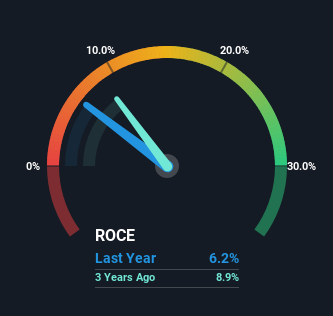Investors Met With Slowing Returns on Capital At Kuala Lumpur Kepong Berhad (KLSE:KLK)

If you're not sure where to start when looking for the next multi-bagger, there are a few key trends you should keep an eye out for. In a perfect world, we'd like to see a company investing more capital into its business and ideally the returns earned from that capital are also increasing. If you see this, it typically means it's a company with a great business model and plenty of profitable reinvestment opportunities. However, after briefly looking over the numbers, we don't think Kuala Lumpur Kepong Berhad (KLSE:KLK) has the makings of a multi-bagger going forward, but let's have a look at why that may be.
What Is Return On Capital Employed (ROCE)?
For those who don't know, ROCE is a measure of a company's yearly pre-tax profit (its return), relative to the capital employed in the business. Analysts use this formula to calculate it for Kuala Lumpur Kepong Berhad:
Return on Capital Employed = Earnings Before Interest and Tax (EBIT) ÷ (Total Assets - Current Liabilities)
0.062 = RM1.6b ÷ (RM31b - RM5.9b) (Based on the trailing twelve months to December 2023).
Thus, Kuala Lumpur Kepong Berhad has an ROCE of 6.2%. In absolute terms, that's a low return but it's around the Food industry average of 6.9%.
See our latest analysis for Kuala Lumpur Kepong Berhad

In the above chart we have measured Kuala Lumpur Kepong Berhad's prior ROCE against its prior performance, but the future is arguably more important. If you're interested, you can view the analysts predictions in our free analyst report for Kuala Lumpur Kepong Berhad .
What The Trend Of ROCE Can Tell Us
The returns on capital haven't changed much for Kuala Lumpur Kepong Berhad in recent years. The company has employed 61% more capital in the last five years, and the returns on that capital have remained stable at 6.2%. Given the company has increased the amount of capital employed, it appears the investments that have been made simply don't provide a high return on capital.
The Bottom Line On Kuala Lumpur Kepong Berhad's ROCE
In summary, Kuala Lumpur Kepong Berhad has simply been reinvesting capital and generating the same low rate of return as before. And with the stock having returned a mere 3.3% in the last five years to shareholders, you could argue that they're aware of these lackluster trends. Therefore, if you're looking for a multi-bagger, we'd propose looking at other options.
Kuala Lumpur Kepong Berhad does have some risks, we noticed 3 warning signs (and 1 which shouldn't be ignored) we think you should know about.
While Kuala Lumpur Kepong Berhad may not currently earn the highest returns, we've compiled a list of companies that currently earn more than 25% return on equity. Check out this free list here.
Valuation is complex, but we're here to simplify it.
Discover if Kuala Lumpur Kepong Berhad might be undervalued or overvalued with our detailed analysis, featuring fair value estimates, potential risks, dividends, insider trades, and its financial condition.
Access Free AnalysisHave feedback on this article? Concerned about the content? Get in touch with us directly. Alternatively, email editorial-team (at) simplywallst.com.
This article by Simply Wall St is general in nature. We provide commentary based on historical data and analyst forecasts only using an unbiased methodology and our articles are not intended to be financial advice. It does not constitute a recommendation to buy or sell any stock, and does not take account of your objectives, or your financial situation. We aim to bring you long-term focused analysis driven by fundamental data. Note that our analysis may not factor in the latest price-sensitive company announcements or qualitative material. Simply Wall St has no position in any stocks mentioned.
About KLSE:KLK
Kuala Lumpur Kepong Berhad
Engages in the plantation, manufacturing, and property development businesses.
Reasonable growth potential with mediocre balance sheet.


